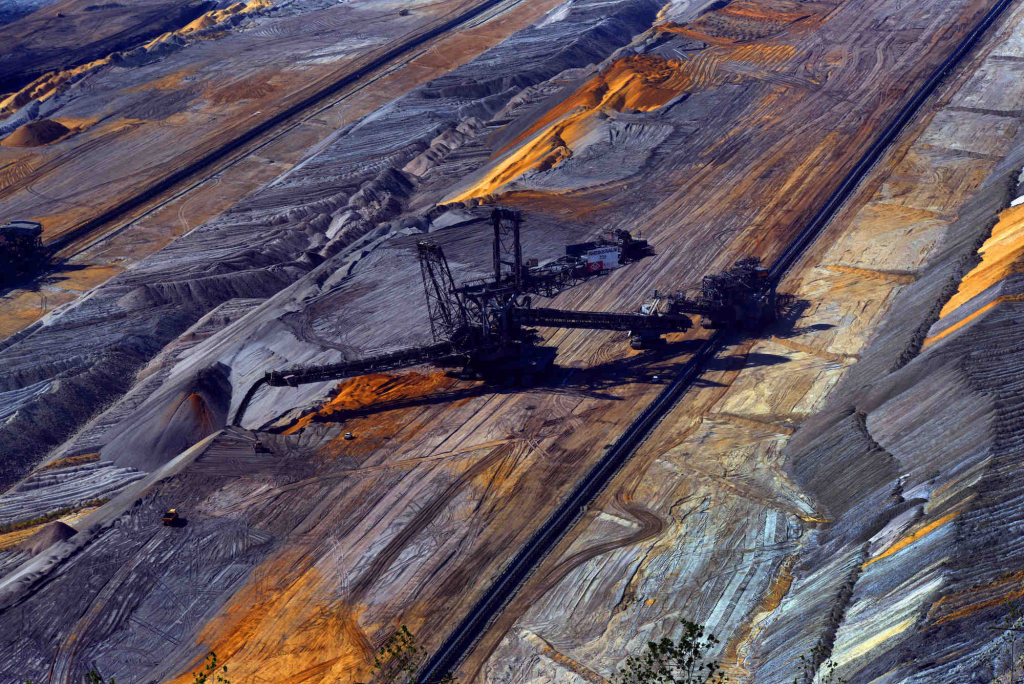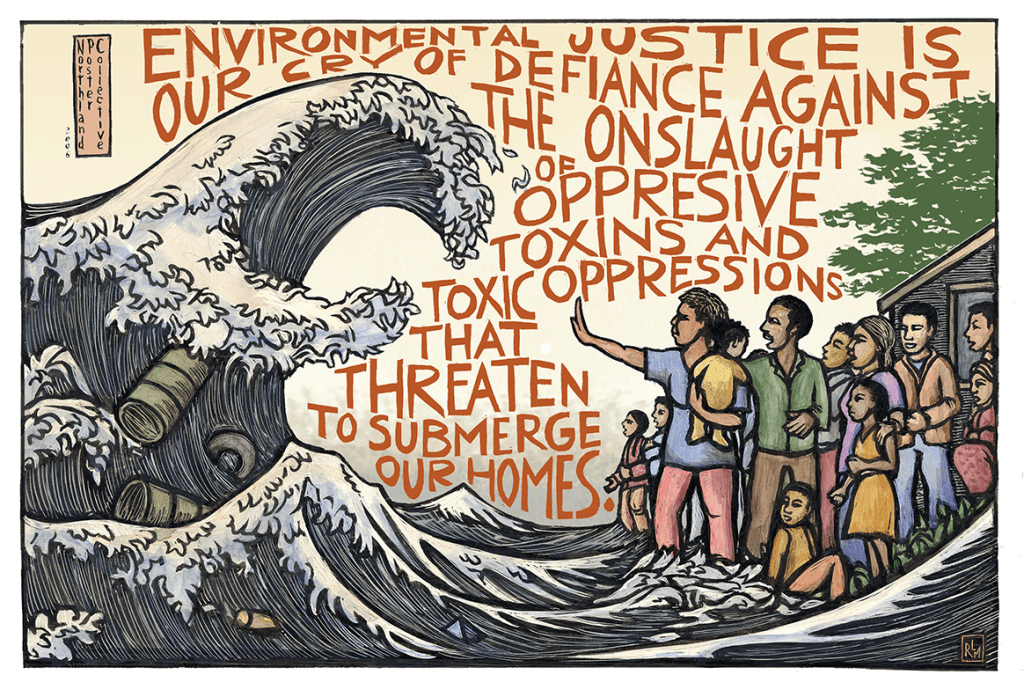In the epoch of the Anthropocene, human activities have become an undeniable force shaping the very foundations of our planet. The importance of environmental justice has never been more evident. As we grapple with the consequences of our actions on Earth’s geology, climate, and ecosystems, it becomes imperative to address the disparities that arise from these changes. This blog aims to explore the Anthropocene and environmental justice from a historical perspective and discuss challenges and solutions.
The first term, “Anthropocene“, represents a recently suggested geological epoch highlighting humans as geological agents shaping Earth systems. This designation is supported by evidence in the geological record and the observable impact on the planet’s climate. On the other hand, environmental justice (EJ) is characterised by the equitable participation of all individuals in environmental decision-making processes. Equal treatment implies that no specific population shoulders an undue burden of adverse environmental effects that are arising from industrial, municipal, or commercial activities.

Source: National Geographic
Historical Perspective
The onset of the Anthropocene has been a subject of extensive debate. One prevalent viewpoint suggests its commencement during the Industrial Revolution of the 1800s. This period marked by significant human-induced alterations to carbon and methane levels in the Earth’s atmosphere. Alternatively, some argue for 1945 as the starting point, coinciding with the testing and deployment of the first atomic bombs, which released detectable radioactive particles globally. However, in 2016, the Anthropocene Working Group reached a consensus. They proposed that the Anthropocene officially began in 1950 with the advent of the Great Acceleration. This moment is characterised by a substantial surge in human activities impacting the planet.
In the Anthropocene, scientists assert that our profound alterations to the earth through human activity have given rise to Anthropogenic climate change and environmental crises on a global scale. The burning of fossil fuels, excessive consumption of material resources, and the generation of extensive waste have disrupted Earth’s ecosystems. This disruption has not only intensified natural hazards but also led to enduring consequences that extend beyond the span of human lifetimes.
The Importance of Environmental Justice in The Anthropocene
Recognising the significance of environmental justice in the Anthropocene goes beyond a moral obligation. It is a pragmatic necessity for shaping a sustainable and fair future. This entails acknowledging the interdependence of environmental and social concerns. In doing so, we actively pursue solutions that prioritise justice for both human and ecological communities. Here are several reasons explaining why we should prioritise the importance of environmental justice:
- Promote Equity and prevent Environmental Racism: Environmental justice aims to address historical injustices, particularly instances of environmental racism. These have unfairly impacted minority and low-income communities with environmental hazards. By prioritising environmental justice, we actively strive to dismantle discriminatory practices and prevent the continuation of such disparities. This ensures that the benefits and burdens of environmental decisions are distributed fairly among all communities.
- Public Health: Many environmental hazards, such as pollution and exposure to toxins, can have severe implications for human health. We ensure that everyone has the right to live in a healthy environment by reducing the health disparities that often afflict marginalised communities.
- Climate Change Impacts: Within the Anthropocene, disadvantaged communities frequently bear the brunt of severe consequences of the climate change. These range from extreme weather events to escalating sea levels.
- Resilience and Adaptation: Communities facing vulnerability are frequently less equipped to withstand the consequences of environmental shifts. Prioritising environmental justice entails endorsing adaptive measures that strengthen the resilience of these communities in the context of climate change, guaranteeing their ability to manage and rebound from environmental disruptions.

Source: “Great Wave” print by Japanese artist Hokusai
The Awakening of environmental Justice: Climate Change and Social inequality
The world’s richest 1 percent of the population is responsible for more than twice as much emissions as the poorest 50 percent. This led to the awakening of environmental justice in recent years, which can be attributed to several interconnected factors, reflecting a growing recognition of the urgent need to address environmental challenges in a socially equitable manner.
The connection between climate change and social inequality is intricate, amplifying existing disparities and disproportionately impacting vulnerable populations. The disproportionate impacts include vulnerability in low-income and minority communities, both nationally and globally, reflecting historical inequalities in emissions, resources, and adaptation capacity.
Climate change exacerbates fragility and heightens the likelihood of conflict and disasters. Climate-induced disasters emerged as the primary cause of internal displacement over the past decade, compelling an estimated 32 million individuals to leave their residences in 2022. The impact of climate change on hunger is already evident—displacing people from their livelihoods, homes, and communities due to climate shocks and ongoing environmental stress. Among those most vulnerable to displacement are indigenous peoples.
Source: BBC Report
Moving Forward
Advancing environmental justice requires a comprehensive approach involving policy changes, community engagement, and individual actions. Key strategies include advocating for policies that address environmental disparities, supporting community-led initiatives, and fostering awareness through education.
Research and data collection on environmental injustices are crucial for informed decision-making. Added to those collaborations and partnerships among various stakeholders, including corporations can lead to a comprehensive solution. On the other hand, recognising the intersectionality of environmental justice with other social issues and promoting green jobs and economic opportunities are essential aspects. Also, we need to encourage individual actions, such as sustainable lifestyle choices and community participation, which further contribute to building a future where environmental justice is integral to decision-making and ensures equal access to a healthy and sustainable environment for all communities.
achieving the United Nations Sustainable Development Goals (SDGs) and how they link to the importance of environmental Justice
Environmental justice and the UN SDGs are interconnected, as both seek to address social, economic, and environmental challenges. Here are some key connections between environmental justice and the UN SDGs:
- SDG 1: Environmental justice addresses the disproportionate impact of environmental degradation on low-income communities. By promoting equitable access to resources and opportunities, it contributes to poverty alleviation.
- SDG 3: Environmental justice advocates for the right to a clean and healthy environment. Hence this can contribute to achieving the goal of good health and well-being for all.
- SDG 10: Environmental justice focuses on ensuring that no particular group bears a disproportionate burden of environmental harm. This aligns with the goal of reducing inequalities within and among countries.
- SDG 11: Environmental justice advocates for sustainable urban planning and development, regardless of socioeconomic status or background. This aligns with the goal of creating sustainable cities and communities.
- SDG 13: Environmental justice is tied to climate action, as it addresses the unequal impacts of climate change on communities. It calls for just and equitable solutions to mitigate and adapt to climate change.
- SDG 15: Environmental justice advocates for the protection of terrestrial ecosystems and biodiversity by addressing issues such as deforestation and habitat loss that disproportionately affect certain communities.
A Thrivable Framework
Thrive proposes a transformative approach to conservation and social equity. Our framework goes beyond mere sustainability to focus on creating conditions, where both nature and communities can flourish. At Thrive, we are committed to spotlighting innovative solutions that embody this Thrivable Framework. Our research and advocacy explore the complexities of human responsibility in this epoch, from ecological conservation to social justice. We invite you to engage with our informative blog posts and podcast series. Participate in our live webinars to delve deeper into the world of sustainability. Together, we can chart the course towards a more thrivable future.























